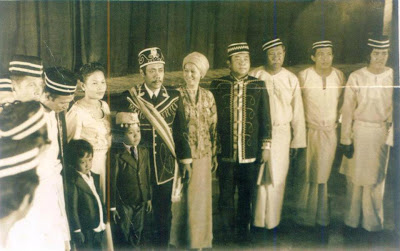A historical black hole for Sabah - There is still a debate about wether North Borneo was a country, a state or a self-government in transition during the first couple of weeks of independence
THE last few days, I pretended to be an alien who only had four news clippings from 1963 to understand Malaysia Day (Sept 16, 1963).
I received the Sabah Times clippings dated Aug 31, Sept 3, Sept 19, and Sept 20 from Danny Wong, my classmate from La Salle Secondary School, Tanjung Aru in Kota Kinabalu.
Professor Dr Danny Wong Tze Ken is a historian who is the director of Universiti Malaya’s Global Planning and Strategy Centre.
I telephoned him a few days before Merdeka Day as I was writing an article on the formation of Malaysia.
“Do you know whether at the time the Union Jack was lowered in Kota Kinabalu on Aug 31, 1963, a Sabah flag was raised?” I asked.
“I don’t have the information off hand. Let me do some research and I’ll email you,” said the historian.
A few hours later, Wong wrote: “Just some pages from four issues of Sabah Times for your perusal. There’s mention of the Sabah flag, but no Union Jack.”
I then pored through four news clippings from the Sabah newspaper now called the New Sabah Times.
There’s a historical black hole on the status of Sabah from Aug31, 1963 (the day the British granted self-government to North Borneo, which Sabah was then called) to Sept 16, 1963 (when Sabah, Sarawak, Singapore and Malaya formed the Federation of Malaysia). I’ve had endless debates with historians, politicians and laymen on the subject.
Some think that Sabah was a country. Some think it was a state. Some think it was a self-government in transition to form Malaysia.
The romantic in me would like to think that my state was a country before it became part of Malaysia. But let me answer that question as an alien (who read four pages of Sabah Times).
The front page on Aug 31, 1963 was: “Sabah’s Historic Day”.
“Self-government means more responsibility,” said Donald Stephens, Sabah’s first Chief Minister who later became Tun Fuad Stephens.
“To me, as it must be to all people in Sabah, today is significant as the day on which we gain self-government,” he said.
Stephens also said: “Sabah Day will be remembered by our sons and daughters and their children’s children as the day on which we were handed over the reins of government of our own country.”
On the left of the article was a story with a headline “Give Your Full Support To Your New Govt – Governor.” The North Borneo Governor Sir William Goode’s Sabah Day greeting was: “Today is a historic day for Sabah. It marks the beginning of self-government and independence and the end of Colonial government.”
In the centre of the front page was an article “UN Team Receives Same Answer at Papar, Jesselton – ‘Malaysia Malaysia’.
“PAPAR: At Papar, the UN Team was first greeted by three posters by the side of the railway station. They read: “No Interference to the formation Malaysia on Aug 31 (1963)”, “Don’t waste time, Referendum Not Necessary” and “Go Home, Don’t Waste Time”.
The United Nations team was at Papar, a town about 30 minutes from Jesselton (as Kota Kinabalu was once called), for a hearing on Sabahans’ views about Malaysia.
Chan Chin On, who represented the Papar Branch of Sabah Alliance said, “after studying the pros and cons for the past two years, The Alliance had come to the conclusion that Malaysia was best for them as it would bring stability, economic development and prosperity.”
He said, “In Malaysia the people of the territories shared many things in common such as education, customs, language, religion and culture.”
Also on the front page was the headline: “Nasution gets tougher.” “JAKARTA: The Indonesian Defence Minister and Chief of Staff of the Armed Forces, General Nasution, said that Indonesian people fully support the struggle of the North Kalimantan (North Borneo) people for their rights of self-determination.”
I, the alien (from outer space and not southern Philippines), was clueless as to why Nasution got tougher. The answer was on page 2 of the Sept 19, 1963 clipping.
In an editorial, Sabah Times wrote: “The strained relations between Malaysia and Indonesia have reached saturation point. Now it is either going to be a shooting hostility or eternal peace between the Malaysian region and Indonesia. The cards are down and the latter looks most impossible.”
“Latest reports indicated that Indonesians have decided upon the issue by burning the British Embassy building in Jakarta,” it continued.
“This could mean a retaliation against the angry demonstration held by more than 1,000 Malaysians in Kuala Lumpur yesterday when they smashed the Indonesian Embassy building in the Federal Capital and tore down the Indonesian flag and crest.”
The page 7 clipping dated Sept 3, 1963 was deja vu for most Sabahans. The headline was “Filipino launch seized”.
“LAHAD DATU: A motor launch named MANILA with 127 persons on board and a cargo of household appliances was captured by a Marine Police patrol boat here. According to reliable sources the launch was first seen at Tanjong Labian.”
The report revealed that Sabah’s PTI (Pendatang Tanpa Izin or illegal immigrant) problem had been there since 1963. It just got bigger in the 1990s and 2000s so that in some districts in Sabah, the illegal immigrants outnumber the locals.
Interestingly, if you fast forward to 2013, Tanjung Labian was the gunbattle scene in the Sulu invasion.
Page 6 and Page 7 of the Sept 20, 1963 Sabah Times revealed that my state was sexually liberal in the 1960s. The headlines screamed: “Jesselton goes gay on Malaysia Day” and “Beaufort goes gay”.
One Man's Meat by Philip Golingai The Star/Asia News Network
Related posts:
THE last few days, I pretended to be an alien who only had four news clippings from 1963 to understand Malaysia Day (Sept 16, 1963).
I received the Sabah Times clippings dated Aug 31, Sept 3, Sept 19, and Sept 20 from Danny Wong, my classmate from La Salle Secondary School, Tanjung Aru in Kota Kinabalu.
Professor Dr Danny Wong Tze Ken is a historian who is the director of Universiti Malaya’s Global Planning and Strategy Centre.
I telephoned him a few days before Merdeka Day as I was writing an article on the formation of Malaysia.
“Do you know whether at the time the Union Jack was lowered in Kota Kinabalu on Aug 31, 1963, a Sabah flag was raised?” I asked.
“I don’t have the information off hand. Let me do some research and I’ll email you,” said the historian.
A few hours later, Wong wrote: “Just some pages from four issues of Sabah Times for your perusal. There’s mention of the Sabah flag, but no Union Jack.”
I then pored through four news clippings from the Sabah newspaper now called the New Sabah Times.
There’s a historical black hole on the status of Sabah from Aug31, 1963 (the day the British granted self-government to North Borneo, which Sabah was then called) to Sept 16, 1963 (when Sabah, Sarawak, Singapore and Malaya formed the Federation of Malaysia). I’ve had endless debates with historians, politicians and laymen on the subject.
Some think that Sabah was a country. Some think it was a state. Some think it was a self-government in transition to form Malaysia.
The romantic in me would like to think that my state was a country before it became part of Malaysia. But let me answer that question as an alien (who read four pages of Sabah Times).
The front page on Aug 31, 1963 was: “Sabah’s Historic Day”.
“Self-government means more responsibility,” said Donald Stephens, Sabah’s first Chief Minister who later became Tun Fuad Stephens.
“To me, as it must be to all people in Sabah, today is significant as the day on which we gain self-government,” he said.
Stephens also said: “Sabah Day will be remembered by our sons and daughters and their children’s children as the day on which we were handed over the reins of government of our own country.”
On the left of the article was a story with a headline “Give Your Full Support To Your New Govt – Governor.” The North Borneo Governor Sir William Goode’s Sabah Day greeting was: “Today is a historic day for Sabah. It marks the beginning of self-government and independence and the end of Colonial government.”
In the centre of the front page was an article “UN Team Receives Same Answer at Papar, Jesselton – ‘Malaysia Malaysia’.
“PAPAR: At Papar, the UN Team was first greeted by three posters by the side of the railway station. They read: “No Interference to the formation Malaysia on Aug 31 (1963)”, “Don’t waste time, Referendum Not Necessary” and “Go Home, Don’t Waste Time”.
The United Nations team was at Papar, a town about 30 minutes from Jesselton (as Kota Kinabalu was once called), for a hearing on Sabahans’ views about Malaysia.
Chan Chin On, who represented the Papar Branch of Sabah Alliance said, “after studying the pros and cons for the past two years, The Alliance had come to the conclusion that Malaysia was best for them as it would bring stability, economic development and prosperity.”
He said, “In Malaysia the people of the territories shared many things in common such as education, customs, language, religion and culture.”
Also on the front page was the headline: “Nasution gets tougher.” “JAKARTA: The Indonesian Defence Minister and Chief of Staff of the Armed Forces, General Nasution, said that Indonesian people fully support the struggle of the North Kalimantan (North Borneo) people for their rights of self-determination.”
I, the alien (from outer space and not southern Philippines), was clueless as to why Nasution got tougher. The answer was on page 2 of the Sept 19, 1963 clipping.
In an editorial, Sabah Times wrote: “The strained relations between Malaysia and Indonesia have reached saturation point. Now it is either going to be a shooting hostility or eternal peace between the Malaysian region and Indonesia. The cards are down and the latter looks most impossible.”
“Latest reports indicated that Indonesians have decided upon the issue by burning the British Embassy building in Jakarta,” it continued.
“This could mean a retaliation against the angry demonstration held by more than 1,000 Malaysians in Kuala Lumpur yesterday when they smashed the Indonesian Embassy building in the Federal Capital and tore down the Indonesian flag and crest.”
The page 7 clipping dated Sept 3, 1963 was deja vu for most Sabahans. The headline was “Filipino launch seized”.
“LAHAD DATU: A motor launch named MANILA with 127 persons on board and a cargo of household appliances was captured by a Marine Police patrol boat here. According to reliable sources the launch was first seen at Tanjong Labian.”
The report revealed that Sabah’s PTI (Pendatang Tanpa Izin or illegal immigrant) problem had been there since 1963. It just got bigger in the 1990s and 2000s so that in some districts in Sabah, the illegal immigrants outnumber the locals.
Interestingly, if you fast forward to 2013, Tanjung Labian was the gunbattle scene in the Sulu invasion.
Page 6 and Page 7 of the Sept 20, 1963 Sabah Times revealed that my state was sexually liberal in the 1960s. The headlines screamed: “Jesselton goes gay on Malaysia Day” and “Beaufort goes gay”.
One Man's Meat by Philip Golingai The Star/Asia News Network
Related posts:
Independence has been achieved, yet has to be
constantly defended, continuously renewed and expanded as the process
of de-colonisation is o...
Malaysian raise the Jalur Gemilang during the Amanat Merdeka
deliver by Datuk Seri Najib Razak at MATIC..-- M. Azhar Arif/The Star
T...































